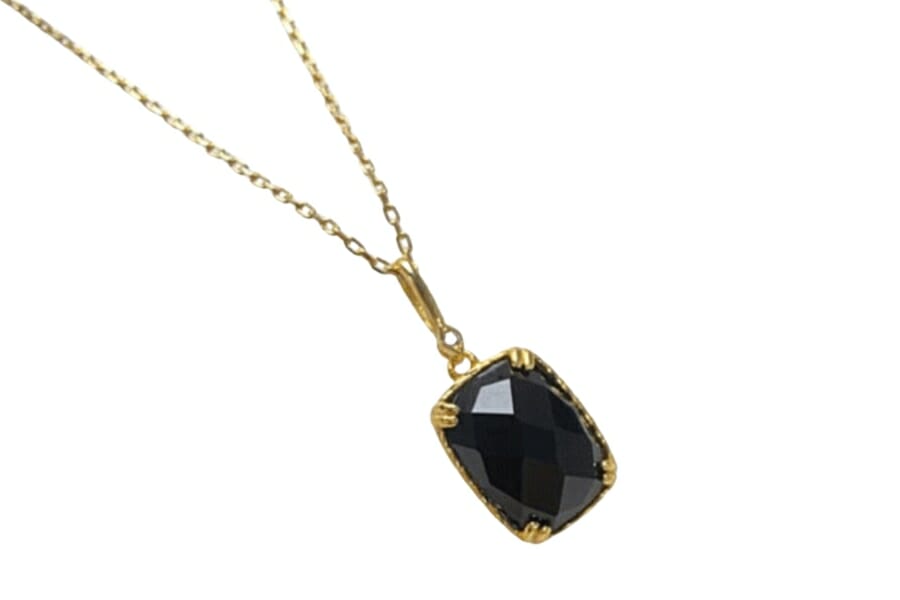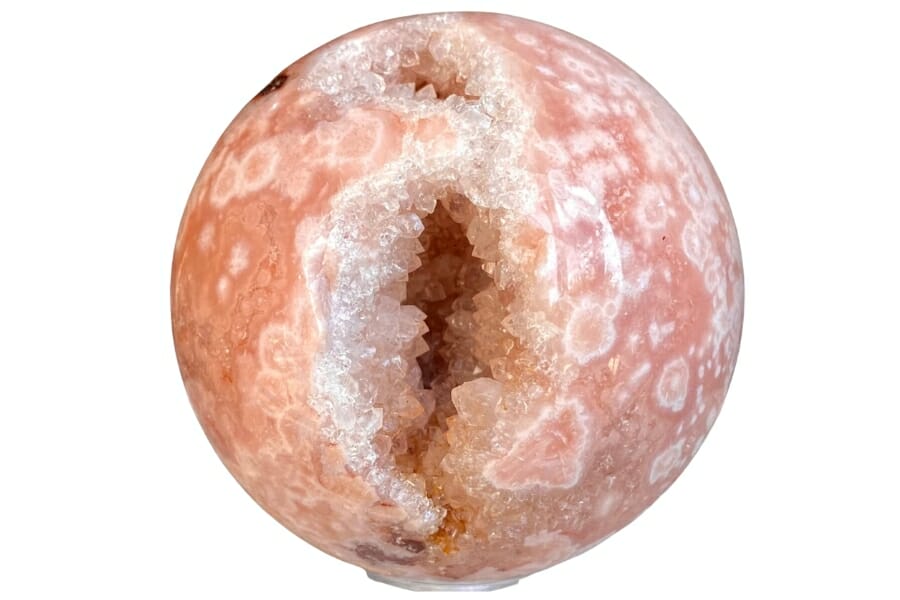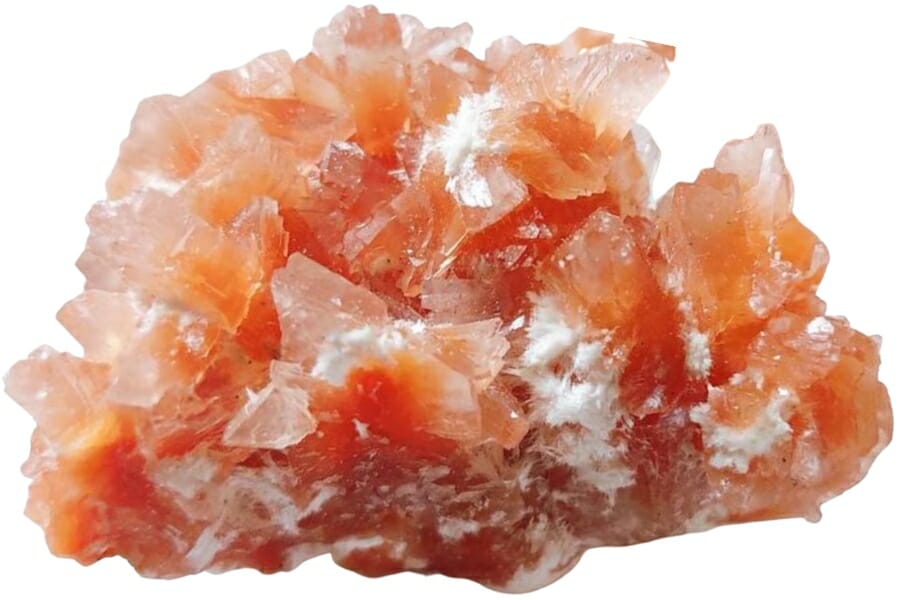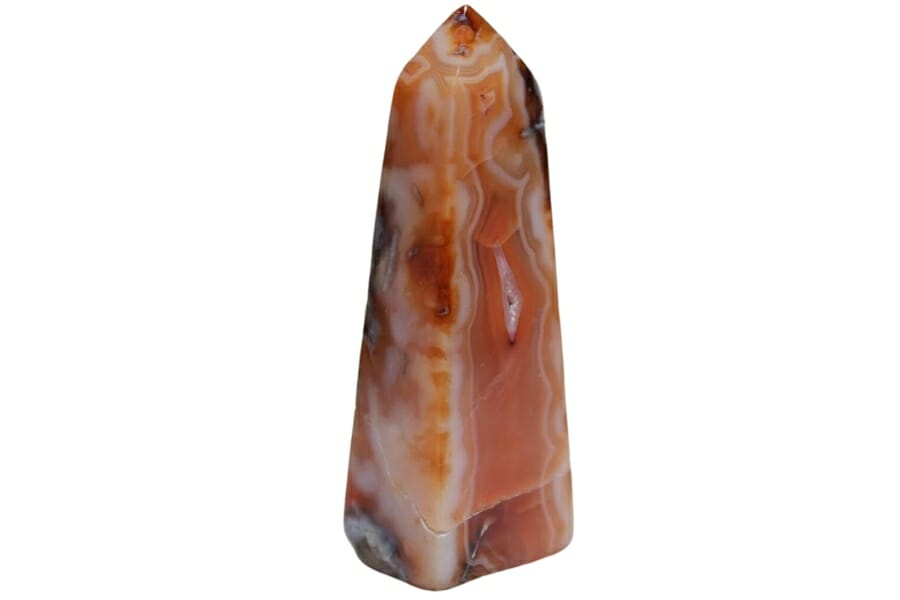The gemstone carnelian is bright and warm-colored. It’s a type of chalcedony that comes in a beautiful range of reds, from a light orange to a deep red-brown.
This semiprecious stone has been prized for its bright color and used in jewelry, carvings, and as an artist’s medium for a long time. Many believe it has spiritual properties that make them braver, more motivated, and more creative.
In this article, we’ll show you some of the different landscapes in the US and point out the places known for having lots of carnelian. This guide is meant to help you find your way into the fascinating world of carnelian.
What Carnelian is

The semiprecious stone carnelian is a type of chalcedony that ranges from red to orange. It comes in clear and cloudy forms, and its bright color comes from iron impurities.
Carnelian forms in volcanic and metamorphic rocks when silica-rich solutions get into cracks and slowly crystallize as pressures and temperatures change.
Gem enthusiasts and collectors can find large deposits worldwide, including in India, Brazil, and Uruguay, as well as in the United States at places like the Oregon coast and the Great Lakes region.
The different types of Carnelian
Carnelian is loved for its bright colors, which range from pale orange to a rich, deep red. This semiprecious stone looks different because of iron impurities, transparency, and random patterns.
These factors create several types, such as the highly sought-after red carnelian and the more uncommon banded variety.
Black Carnelian

Black carnelian is a rare and different type of chalcedony. It stands out because of its dark, almost black color, which is very different from the usual reds and oranges associated with carnelian.
Its unique color comes from having more iron impurities and microcrystalline inclusions, which make it look opaque most of the time. Traditional carnelian deposits can be found in many places, such as India, Brazil, and the United States.
However, black carnelian deposits are more limited in where they can be found. It comes mostly from certain places, like South Africa and Uruguay, making it rare and desirable among gem collectors and enthusiasts.
Combining the fact that black carnelian is hard to find with its strange appearance makes it stand out among gemstones.
Blue Carnelian

This blue carnelian is a unique and rarely seen type of the usually red-orange carnelian family. Its unusual blue color stands out.
This color difference comes from trace elements and the specific conditions in the environment at the time it was formed. It sets it apart from the more common carnelian colors caused by iron oxides.
Traditional carnelian is often found in India, Brazil, and the United States. However, blue carnelian is uncommon; the only reliable reports of it being found are in deserts like the Sahara.
Due to its scarcity and beautiful color, blue carnelian is a gem that collectors and enthusiasts worldwide want very much.
Brown Carnelian

Brown carnelian is a type of standard carnelian loved for its earthy, deep brown tones, different from the bright reds and oranges typical of standard carnelian.
Geological conditions and a higher concentration of iron impurities cause this unique shading. Traditional carnelian can be found in India, Brazil, and the United States, among other places.
Brown carnelian, on the other hand, is harder to pinpoint. It is usually found where other chalcedony minerals are found, rather than in a single, well-known place.
It’s a unique find for gem collectors and connoisseurs looking for something different in the carnelian family. Its subtle coloration gives it a soft elegance.
Orange Carnelian

Orange carnelian is a well-known and traditional type of chalcedony quartz. It is valued for its bright, energizing colors, ranging from a soft orange to a strong, fiery color.
Its color, which comes from iron oxides, makes it different from the darker red or brown types. Carnelian is generally found in India, Brazil, and the United States.
However, the bright orange variety is often found in India and some South America. Orange carnelian is a popular stone for jewelry and healing because its bright, sunny color makes people feel happy and creative. It is also valued for its spiritual and aesthetic qualities.
Pink Carnelian

Pink carnelian is a unique and beautiful variation of the red-orange carnelian family. It stands out for having soft pinkish colors. This soft color comes from fewer iron oxides than traditional carnelian, a brighter stone.
The common red-to-orange carnelian comes from places like India, Brazil, and the United States. On the other hand, the pink variety doesn’t have a clear source, so it’s harder to find in the gem market.
Its soft pink tones make you feel calm and peaceful, making pink carnelian a unique treasure for collectors and people who want to believe it can heal.
Red Carnelian

Red carnelian is the most famous type of this type of chalcedony. It’s valued for its fiery red colors, from iron impurities in its silica structure. Carnelian, found in certain places, has stronger shades of this bright red.
Large deposits exist in India, Brazil, and parts of the United States, like the Oregon coast. Red carnelian is unique not only because of its bright color, which stands for passion and life, but also because of its historical importance.
In ancient times, people loved and used it in art and jewelry. They also thought it gave them strength and courage. Red carnelian is a classic gemstone because it has a long history and a beautiful appearance.
Where to find Carnelian
Gem lovers will enjoy finding carnelian in the United States because this semiprecious stone is known for its vivid colors and unique patterns.
This section will take you to well-known places where you can go on a treasure hunt for this beautiful stone.
Antelope Valley, Nevada

Nevada’s Antelope Valley is a gem collectors’ dream, with a huge variety of agates, chalcedonies, and the highly sought-after carnelian. Due to the area’s volcanic history, the unique geological conditions make carnelian a very good gemstone.
While collecting in this area, people often find carnelian in a variety of warm colors, ranging from soft yellows to deep reds. It’s often bright and clear, making it perfect for lapidary work.
An easy-to-reach location and the chance to find fine specimens make Antelope Valley a popular and rewarding spot for casual and serious collectors.
Big Sur, California

Big Sur, California, is a great place to find carnelian because of its beautiful coastline and mineral-rich land. The area’s rough geological history has produced many types of chalcedony, with carnelian being one of the most notable.
The gemstone is often washed off of the rocky cliffs and formations here and ends up in the Pacific, where the waves and sand polish it naturally. Carnelian in Big Sur comes in beautiful colors, from fiery oranges and reds to softer sunset colors.
It’s often very clear and great for making jewelry. Carnelian collectors can’t stay away from Big Sur because of its beautiful scenery and the thrill of finding gems polished by the ocean.
Graveyard Point, Idaho

Graveyard Point, situated near the Oregon-Idaho border, is famed among gem enthusiasts for its extensive chalcedony beds, which include an impressive variety of carnelian.
The area’s volcanic history created prime conditions for silica deposition, leading to the formation of these gemstones. Carnelian from Graveyard Point is prized for its quality and diversity in color, typically showcasing a spectrum from rich, deep reds to clear, sunny oranges, often marked with unique patterns and banding.
The site’s relative accessibility and the high likelihood of finding substantial specimens make it a favored destination for collectors seeking the vibrant beauty and natural artistry inherent in carnelian.
Washington State Beaches, Washington

The rough beaches in Washington State are famous for the many treasures people have found there, especially carnelian.
The state’s complicated geological history, including volcanic activity and the movement of glacial ice, has helped form and spread many minerals, such as different types of chalcedony.
Carnelian often has a classic clear appearance, and its colors range from light orange to a deeper red-orange. The colors are brought out even more by the way the waves in the Pacific tumble it.
The best time to find these gems is to go beachcombing after a storm or high tide. This makes Washington’s beaches an exciting place for collectors and fans who want to find a carnelian that has been naturally polished.
Yellowstone River, Montana

The Yellowstone River in Montana is a good place to look for carnelian because it is known for its beautiful scenery and long geological history.
As the river flows through sedimentary and volcanic rock formations, it wears away and carries away many minerals, some of which are valuable gemstones.
The warm red-to-orange color of the carnelian in this area comes from the iron oxides in the stones, and the river’s currents tend to smooth them out over time.
Exploring the Yellowstone River is a fun and relaxing for gem hunters and nature lovers. It’s exciting to find carnelian among the rocks in the riverbed.
How to find Carnelian
You can look for carnelian in a lot of different ways. Every new path has one of these pretty stones. Let us take a better look!
Check surface features
To identify carnelian, you must pay close attention to its unique surface features. Learning how to do this can greatly improve your chances of finding more of this gemstone.
The most noticeable thing about carnelian is its unique color range, mostly orange to reddish shades. But the stone’s ability to be see-through is also very telling.
If you hold a real carnelian up to a light, it will often glow, showing that it is translucent and has a uniform coloration, unlike other stones that look the same but might have different shades or other inclusions.
Observe the color
To successfully identify carnelian in nature, you need to recognize its unique surface features, which can help you find more specimens during your searches.
Carnelian is mostly known for its bright red-orange color, which comes from iron impurities.
But the fact that it is see-through is a key sign of authenticity; real carnelian will let light pass through and glow when held up to the sun, which makes it different from other stones of the same color.
Use a light source
A light source is an important tool for correctly identifying carnelian, making it much easier to tell this gemstone apart from others. One thing that makes carnelian unique is that it’s clear.
If you hold a real carnelian stone up to a light, it will glow and show a rich, consistent color without any cloudy inclusions or markings common in stones that look like it.
Carrying a small LED flashlight or other portable light source can be very helpful when looking for a carnelian in the field, especially on beaches, riverbeds, or rocky ground.
Shine a light through possible finds; stones that let light through and show the typical orange to reddish colors are most likely valuable. This method works especially well when there isn’t much light because carnelian has a unique glow that can stand out.
How to identify Carnelian once you find it
There are many ways that carnelian are different from other gems that make them special. Let’s talk about how to find a carnelian in a group of stones.
What Carnelian looks like on the outside
Different types of carnelians can have very different looks on the outside. In general, look for these things:
Luster

On the outside, rough carnelian doesn’t usually have a bright sheen like polished carnelian does. It also doesn’t look like glass or clear like polished carnelian does. Carnelian has an earthy, matte surface when it is not processed.
This is mostly because of the leftover matrix and impurities surrounding it when it forms in host rocks or sediment. This covering can appear as a crusty, cloudy, or even dusty surface that doesn’t reflect light but scatters it, giving the stone a dull, lifeless look.
The carnelian’s true luster, which can range from waxy to vitreous, is only seen when this outer layer is removed and the stone is cut and polished. This makes the gem a beautiful, bright gem that reflects light.
This big difference between the two colors shows why rough carnelian is often missed during hunts: its plain outside hides the valuable gem inside.
Surface markings

Rough carnelian has markings on its surface that are very different from its polished form, which looks smooth and uniform. When carnelian is found in nature, it’s usually surrounded by a matrix or host rock, which gives it a rough, uneven outside.
The stone’s surface may have different patterns, such as pits, grooves, ridges, and spots of different colors caused by mineral impurities or oxidation. Rough carnelian may also have striations or patterns that were formed by geological processes.
Sometimes, it may also have small quartz crystals or other mineral deposits that make it look even more complicated. The markings on the stone show where it came from naturally and the changing conditions in which it formed.
Fans and collectors need to be able to spot carnelian in the wild, among other rocks and minerals, by recognizing these signs.
Translucency

At first glance, it can be hard to tell that rough carnelian is clear because its rough surface makes it look opaque. Carnelian is usually covered in a matrix or has a worn-down surface that hides the fact that it is naturally clear.
In its raw state, the stone may look cloudy, with a crusty or dusty covering that makes it hard for light to pass through. If, on the other hand, a piece of this exterior is broken or worn down, clear spots may show through, showing the hidden gem inside.
For the skilled eye, this flash of light going through, showing colors ranging from pale orange to deep red, can be a sign that carnelian is present.
To identify rough carnelian, one usually has to carefully look at possible specimens or physically examine them to find the clear spots that identify this highly sought-after chalcedony.
What Carnelian looks like on the inside
Inside a carnelian doesn’t always look the same as the outside. Most of the time, it’s brighter or more concentrated on the inside. The following can be seen:
Consistent color

Rough carnelian has a consistent color on the inside that really makes it stand out, which is a visual clue that is often hidden by a plain exterior. The color of carnelian is uniform once the outer matrix is gone or worn away.
It can be a pale, almost milky orange color or a deep, rich red or brown color, with fiery orange colors being the most common. Because it has iron oxides in it, the color stays the same. This makes it different from other stones that may be the same color but have different patterns or inclusions.
The consistent color of carnelian makes it unique, and people love it for being warm and colorful. This even color gives the stone a sense of depth and solidity, which makes it a valuable material for jewelry and other decorative arts.
Lack of inclusions

Rough carnelian’s interior is clear because it doesn’t have any inclusions, which is one of the things that makes this chalcedony unique. When you look inside some gemstones, you might find different things.
Carnelian is beautiful because it has a single color that goes through it. Because it has no inclusions (foreign materials, voids, or fractures), it is clear and its bright colors are spread out evenly.
Not only does this make the stone look better, but it also makes it more valuable, since stones with uniform color and transparency are sought after.
Carnelian is a popular gemstone among collectors and gem lovers because it has no internal distractions. It represents simplicity, elegance, and the natural beauty of things.
Smooth texture

When carnelian is taken out of its rough shell, the inside is surprisingly smooth, which is different from the rough outside it usually has in its natural state. The stone is naturally smooth because it has a fine-grained microcrystalline structure.
This type of structure doesn’t have the big cracks or jagged inclusions that other minerals do. Carnelian is naturally very smooth, and when it is cut and polished, it shows off its glassy, almost velvety surface.
This lets light pass through and reflect, bringing out the stone’s deep, even colors. This tactile quality is a pleasure to feel and look at, which adds to the gem’s beauty.
The smooth inside of carnelian, which is hidden by its rough outside, is a great example of how nature can hide amazing beauty and simplicity behind a rough exterior.


